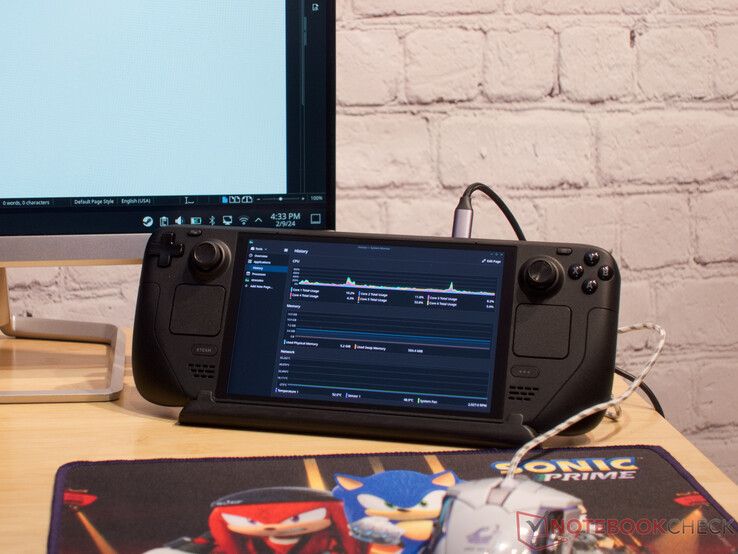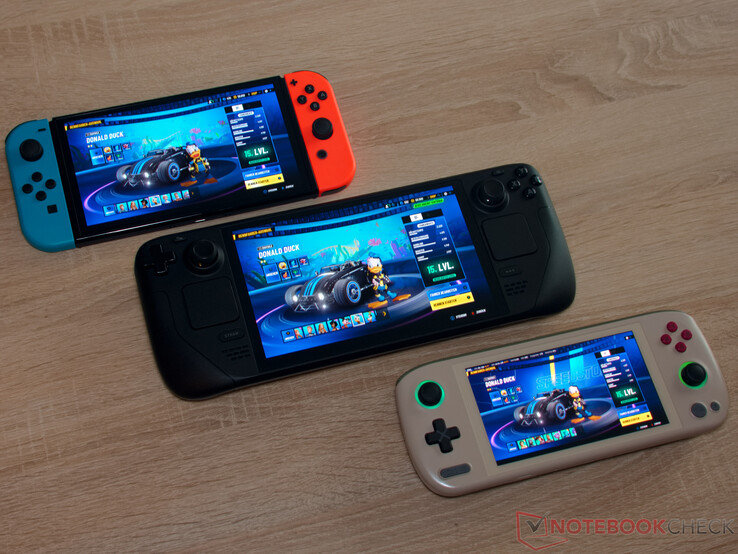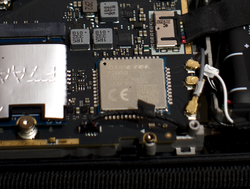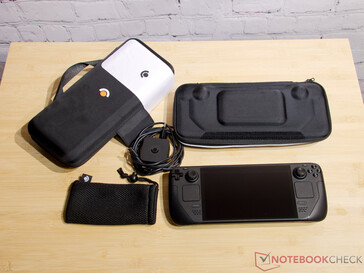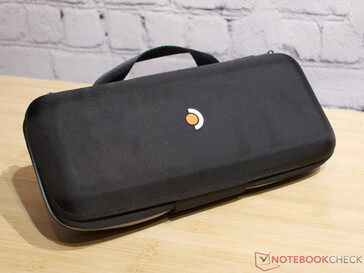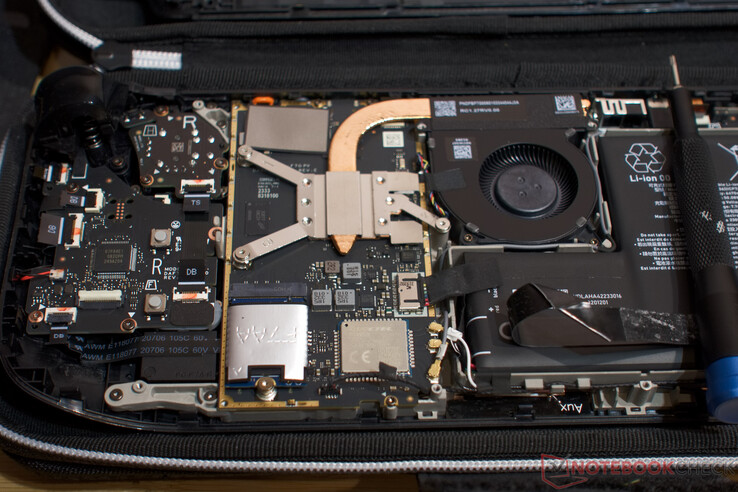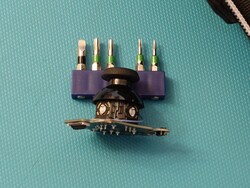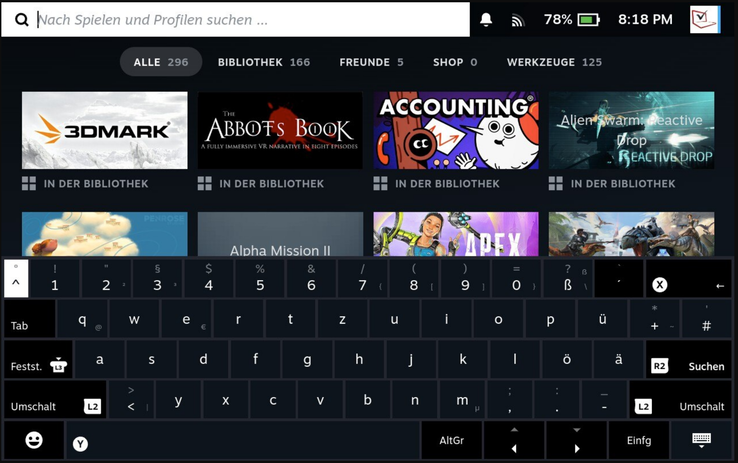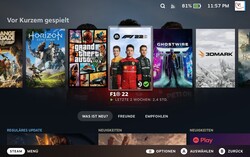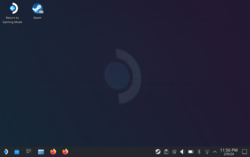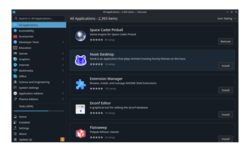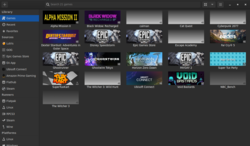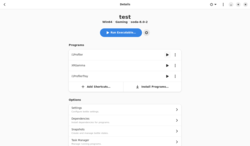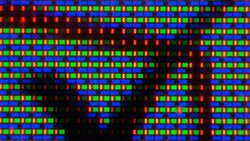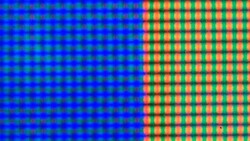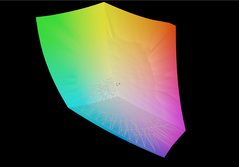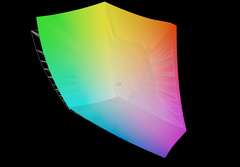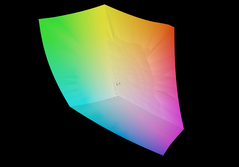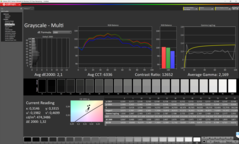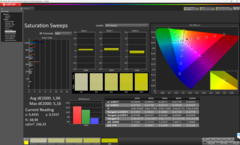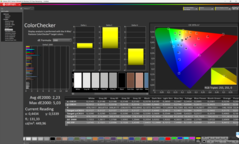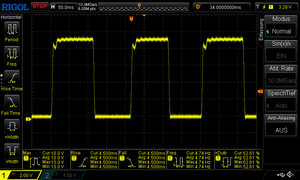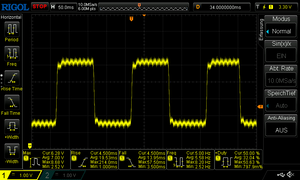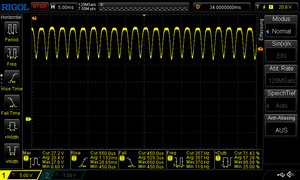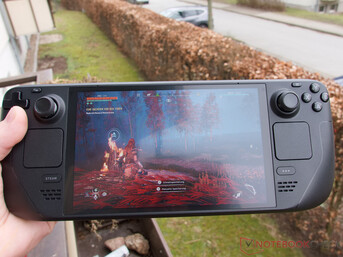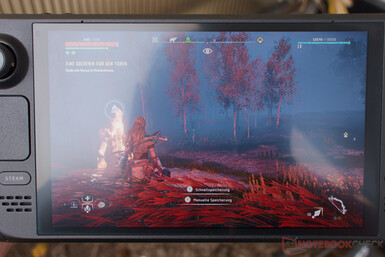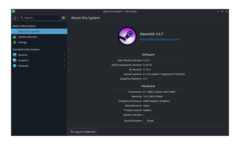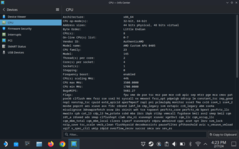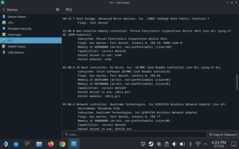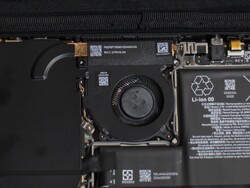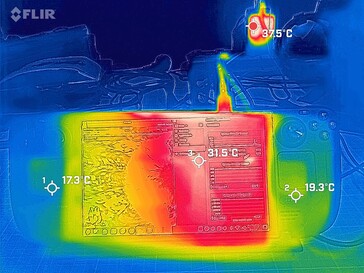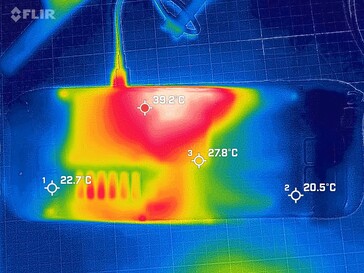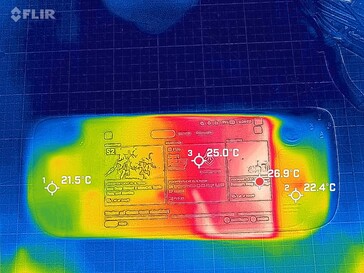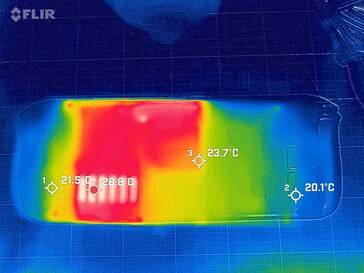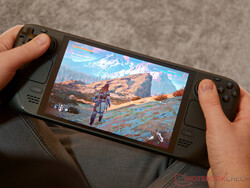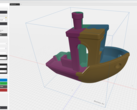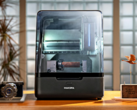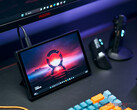Steam Deck 1 TB OLED review: Minimalist performance, maximum gaming fun
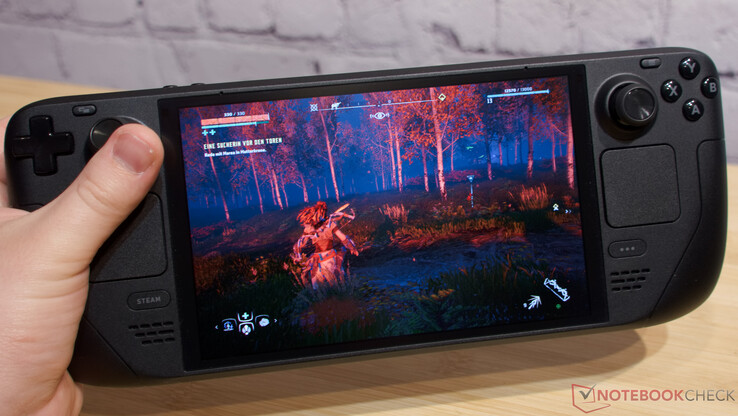
After examining a number of Windows handhelds in recent weeks, it's now time to take a closer look at the original handheld, the Steam Deck, which is now available as the Steam Deck OLED. The device is not an entirely new model compared to the original Steam Deck, as the processor and housing remain largely the same. Hence, the gaming handheld from Valve is considerably weaker in terms of hardware than the Asus ROG Ally, Lenovo Legion Go and the Ayaneo Kun. On the other hand, the Steam Deck scores well in terms of battery life, temperature control and handling. None of the Windows devices and their accompanying software can match the sophisticated elegance of Steam OS.
Like the aforementioned competitors, the Steam Deck also uses an AMD APU that has been specially developed for the gaming handheld. While powerful enough to run current titles smoothly, it is nowhere near the performance level of the AMD Ryzen 7 7840U or the Z1 Extreme. But it doesn't have to be, since the Steam Deck's screen comes with a comparatively low resolution of 1280 × 800. Even the small Ayaneo Air 1S has a Full HD display, while the OneXplayer 2 Pro, Ayaneo Kun and others even boast a 2K resolution. This means the GPU in the Steam Deck doesn't have to work quite as hard. On top of this is the Arch Linux-based Steam OS, an extremely resource-efficient Linux distribution that runs very well, even on older laptops and computers.
We tested a wide range of games and found none that wouldn't run. This is due not only to the carefully curated hardware, but also to Proton and Wine, two program interfaces that enable Linux computers to run Windows applications. This means that more computing power is available for gaming and is not frittered away on pointless background processes from Microsoft.
Possible competitors in comparison
Rating | Date | Model | Weight | Height | Size | Resolution | Price |
|---|---|---|---|---|---|---|---|
| 88.9 % v7 (old) | 02 / 2024 | Valve Steam Deck 1 TB OLED Steam Deck OLED APU, Radeon Radeon Steam Deck 8CU | 640 g | 49 mm | 7.40" | 1280x800 | |
| 85.2 % v7 (old) | 01 / 2024 | Ayaneo Kun R7 7840U, Radeon 780M | 942 g | 22 mm | 8.40" | 2560x1600 | |
| 88.2 % v7 (old) | 10 / 2023 | Ayaneo Air 1S Retro Power R7 7840U, Radeon 780M | 443.8 g | 21 mm | 5.50" | 1920x1080 | |
| 66.3 % | 01 / 2024 | Lenovo Legion Go Z1 Extreme, Radeon 780M | 845 g | 41 mm | 8.80" | 2560x1600 | |
| 84.9 % v7 (old) | 01 / 2024 | ONEXPLAYER 2 Pro AR18 R7 7840U, Radeon 780M | 876 g | 43 mm | 8.40" | 2560x1600 | |
| 87.5 % v7 (old) | 05 / 2023 | Asus ROG Ally Z1 Extreme Z1 Extreme, Radeon 780M | 611 g | 21.22 mm | 7.00" | 1920x1080 |
Case - Simple yet functional
Those who already own a first-generation Steam Deck can skip this part. Visually, hardly anything has changed on the handheld with its 7.4-inch display. The prints on the buttons and the back are now a little less conspicuous, as they are a slightly darker gray than on the 7-inch Steam Deck LCD. The thumb-stick covers are now also black. Both ensure a more uniform appearance overall at the front. The on/off switch, for its part, is somewhat more conspicuous with its new orange color.
The housing of the handheld consists largely of two plastic parts; the joint between the upper and lower shells is hardly noticeable. The entire handheld feels extremely sturdy and, at 637 grams, is one of the lightweights among comparable devices of roughly the same size.
The design of Valve's Steam Deck is obviously a secondary consideration. As the primary emphasis of the gaming handheld is function, it hardly offers anything in the way of form or decorative elements. No RGB lighting nor any colored prints are to be found here.
The ROG Ally and the Steam Deck take up roughly the same amount of space. A Nintendo Switch is significantly slimmer. All three handhelds have roughly the same screen diagonal. However, the Steam Deck is much wider than the ROG Ally owing to the arrangement of the control elements. Those looking for a really small handheld shouldn't overlook the Ayaneo Air 1S.
Equipment - The basics are enough
The Steam Deck has a microSD card reader, a USB-C port and a 3.5 mm audio jack socket. This corresponds to the range of connections on a Nintendo Switch. More is not really needed if the handheld is only required for gaming, but the Steam Deck could also be used as a Linux PC. In such a case, at least one more USB-C port would be desirable here.
SD card reader
The SD card reader is incredibly fast at first glance, but Arch-Linux caches the contents of external storage media. After caching was deactivated, it took around 18 to 20 seconds to transfer 250 images of 4.4 MB each. According to Valve, a UHS-1 card reader is installed in the Steam Deck, which promises transfer speeds of up to 100 MB/s. In the best case scenario, we measured a peak of 72 MB/s with an average of 55 MB/s.
| SD Card Reader | |
| average JPG Copy Test (av. of 3 runs) | |
| ONEXPLAYER 2 Pro AR18 (Angelbird AV PRO microSD) | |
| Lenovo Legion Go | |
| Ayaneo Kun | |
| Asus ROG Ally Z1 Extreme (Angelbird AV Pro V60) | |
| Average of class Handheld / UMPC (20.9 - 201, n=11, last 2 years) | |
| Ayaneo Air 1S Retro Power | |
| Valve Steam Deck 1 TB OLED | |
| maximum AS SSD Seq Read Test (1GB) | |
| Asus ROG Ally Z1 Extreme (Angelbird AV Pro V60) | |
| ONEXPLAYER 2 Pro AR18 (Angelbird AV PRO microSD) | |
| Ayaneo Kun | |
| Average of class Handheld / UMPC (74.7 - 261, n=11, last 2 years) | |
| Lenovo Legion Go | |
| Ayaneo Air 1S Retro Power | |
Communication
A rather unusual Wi-Fi module is installed in the Steam Deck OLED, namely the Quectel FC66E. This soldered component enables connections on the 2.4, 5 and 6 GHz networks and via Bluetooth 5.2.
We ran Iperf3 here in the Linux version from Github. For the 6 GHz network, the results are quite strong. For the 5 GHz network, the Steam Deck does not exceed 1000 MBit/s. Normally, our GTX AX11000 router allows significantly more here, as the comparison with the most recently tested gaming handhelds shows. However, this requires channel expansion to the 2.4 GHz network, which the handheld does not appear to be capable of.
Accessories
The Steam Deck 1 TB OLED comes packed in a two-part bag, which is much more practical than its predecessor or the Lenovo Legion Go. The standard bag is still included with the cheaper models. The two-part bag can be split up thanks to Velcro fasteners, resulting in a slim protective sleeve for the backpack or a slightly larger bag that also offers space for the included 45-watt USB-C power supply and a cleaning cloth (also included). The combination of hardshell case and softshell case is a very positive aspect.
Spare parts, maintenance and modding
Those wanting to customize their Steam Deck will find tons of accessories and modding parts from a number of retailers. A search on Amazon alone reveals docking stations, protective equipment, all kinds of skins and button mods. A popular mod on the Steam Deck is swapping the backplate. Here we find very different information on the compatibility of the parts. In principle, we didn't notice any changes to the dimensions of the case, and the positions of the screws remain the same. However, Phillips screws are used on the Steam Deck LCD and Torx screws on the Steam Deck OLED. This appears to have resulted in conflicting statements about compatibility: JSAUX, for example, writes on its own website that its PC0106 backplate is compatible with the Steam Deck OLED, but that a TR6 screwdriver, which is not included, is required. On Amazon, the same backplate is stated as not being compatible with the Steam Deck OLED. There are similarly different statements about the front plate.
Having a Steam Deck guarantees excellent availability of spare parts. Fans, batteries, storage media, housing parts, input devices and much more can be found not only at iFixit. If stick drift occurs, for example, users can choose from a wide range of options or update to Hall effect sensors.
iFixit gave the original Steam Deck a 7 out of 10 for repairability, and we consider the Steam Deck OLED to be on a similar level. The back cover is actually quite easy to remove: a warning always pops up on the Steam Deck when doing so. Users are advised to have the battery at less than 25% capacity in order to minimize potential hazards during disassembly. Eight Torx 6 screws need to be removed first, followed by a number of clips that hold the case together. These should be levered out using a pick or an opening tool made of soft plastic.
Inside we find a fairly modular structure. The processor, RAM and WLAN module are soldered to the mainboard. There are modules for the input devices, the cooling system, the mass storage and other components. Almost every part can be found online at various spare parts dealers. Interestingly, the Steam Deck OLED has a separate antenna for Bluetooth, which is intended to reduce the latency of connected devices.
Warranty
For citizens in the EU, the United Kingdom, Australia, New Zealand and Canadians from the province of Quebec, Valve does not provide a warranty, but refers to the statutory warranty. This means that a warranty of two years is given in the EU. The manufacturer's warranty in other countries is one year, according to the 'Limited Warranty & Agreement'.
Input devices - Precise inputs even without Hall effect sensors
Input devices are an important aspect of gaming handhelds. While console gamers can simply swap their controllers, the feel and function of a handheld has to be just right. Here, the Steam Deck OLED has thumbsticks with potentiometers, which could potentially be susceptible to the infamous stick drift. However, we were unable to find any reports of such problems with this handheld that were published after Feburary 2022. At that time, a firmware bug was causing trouble. Valve itself wrote that it relies on internal tests and known hardware to avoid such problems. Even if the problem should occur again, we do not foresee any problems with the availability of spare parts, but replacing the thumbsticks isn't quite as trivial as one might think.
In addition to the typical controller buttons, the Steam Deck also has four programmable buttons on the back. There is also a gyroscope control and the programmable touchpads under the thumbsticks. For children and people with small hands, the thumbsticks and the buttons on the back may not always accessible simultaneously.
The thumbsticks themselves also offer a touch-sensitive surface, which can be used to call up additional functions. Depending on the game, a number of preconfigured controller assignments are available. You can also create your own settings at any time. Each button on the Steam Deck can be reassigned. Together with the configurable touchpads, there are virtually no limits to the configuration options, which also makes it possible to play games that do not normally support controllers. More than 30 functions can be assigned to the individual buttons and touchpads.
Several linear motors provide haptic feedback on the Steam Deck. These not only ensure strong vibrations and a clicking sensation on the touchpads, but also provide noticeable feedback when the shoulder buttons are pressed. In terms of input device haptics among recently reviewed handhelds, only the Ayaneo Kun comes close to the quality of the Steam Deck.
Touchscreen
The touchscreen on the Steam Deck OLED responds quickly and precisely to inputs. The matte glass panel is also very smooth, allowing fingers to glide easily over the surface. However, the etched glass is also susceptible to fingerprints. Although this is hardly noticeable when the screen is switched on, they become visible as soon as the handheld is switched off.
On-screen keyboard
Another interesting feature of the Steam Deck is the on-screen keyboard. Valve has come up with its very own system here. The left and right halves of the on-screen keyboard can be operated with the touchpads. Since the touchscreen is very precise, the corresponding character is entered depending on where the finger is firmly tapped. Users only need a little practice to become proficient at entering text quickly on the Steam Deck.
Software, games and Steam OS - Valve does not block games from other stores
Steam OS runs as the operating system on the Steam Deck ex works. Since version 3, it has been based on the Arch Linux distribution. The rolling release distribution is considered to be particularly lean, but has been expanded and heavily modified to include a number of functions. For example, Flatpak is used as package management instead of Pacman. The GUI (graphical user interface) shown depends on the operating mode, as the Steam Deck offers a Desktop Mode and a Game Mode. In Game Mode, an environment is displayed that is reminiscent of the Big Picture Mode of the Steam application under Windows. Desktop Mode is based on a slightly modified KDE Plasma 5, and Windows users should be able to quickly find their way around the desktop environment. Especially since Plasma 5 is considered to be one of the most pleasant and user-friendly desktop environments for Linux.
Owners of a Playstation, Xbox or Nintendo console are accustomed to only being able to buy games from the manufacturer's respective stores. One thus naturally wonders about the possibility of adding games from other libraries. At first glance, the Steam Deck has no options for installing games that do not come from Steam. But once users discover Desktop Mode, this possibility becomes real. Using the Flatpak and Discover package management (preinstalled), users can install various Linux programs on the Steam Deck. Users wanting to use Windows software should definitely take a look at Bottles and Lutris. The former allows almost all Windows programs to be installed and run on Linux, while the latter has been specially developed for managing games on Linux.
Lutris not only makes it easy to download games from almost all game stores, but also allows the installation of a whole host of emulators and the managing of ROMs. We used Lutris to install games from the Epic Store, Amazon Prime Gaming, Good Old Games, Ubisoft Connect, Humble Bundle and EA. We also tried out Gameboy Advance, Playstation 2 and Playstation 3 games from our collection. A link can also be created in SteamOS for each of the games, which allows all games to be launched without having to laboriously switch to Desktop Mode first. However, with games from Ubisoft and Epic, there were occasionally problems when launching games or supporting applications in Game Mode.
Nevertheless, the Steam Deck is open to all games. Thanks to Wine and Proton, there is now hardly a Windows application that doesn't run in Linux. Since Wine is not an emulator, but provides the interfaces that Windows programs expect, users are unlikely to experience any loss of performance.
Display - 7.4-inch OLED with 204 DPI
The Steam Deck OLED comes with an HDR OLED screen. Depending on the configuration selected, this sits behind anti-reflective etched glass or reflective glass. Both variants run the same powerful OLED panel at 1280 × 800. The resolution of the OLED panel is completely sufficient so that individual pixels can hardly be made out with the naked eye. After all, the Steam Deck has more than 200 DPI.
Our screen brightness measurements should be taken with a grain of salt, as the Steam Deck has two brightness sensors to the left and right of the screen that don't appear to be disabled in desktop mode. In our Calman measurements, we only registered 480 cd/m² despite the exposed sensors. In Game Mode with deactivated brightness control, on the other hand, we measured 580 cd/m² in the center of the screen on a white surface. This is more in line with the 600 cd/m² advertised by Steam.
In typical OLED fashion, users can expect a high contrast ratio, true black and strong colors. The matte and anti-reflective screen glass on the Steam Deck OLED 1 TB hardly detracts from the display and ensures that reflections are hardly noticeable. The etching is so fine that individual pixels or even subpixels are clearly delineated. Images thus appear crisp and sharp.
| |||||||||||||||||||||||||
Brightness Distribution: 98 %
Center on Battery: 484 cd/m²
Contrast: 16167:1 (Black: 0.03 cd/m²)
ΔE ColorChecker Calman: 2 | ∀{0.5-29.43 Ø4.77}
ΔE Greyscale Calman: 2 | ∀{0.09-98 Ø5}
96.1% AdobeRGB 1998 (Argyll 3D)
100% sRGB (Argyll 3D)
99.6% Display P3 (Argyll 3D)
Gamma: 2
CCT: 6336 K
| Valve Steam Deck 1 TB OLED ANX7530 U, OLED, 1280x800, 7.4" | Ayaneo Kun Ayaneo 2K, IPS, 2560x1600, 8.4" | Ayaneo Air 1S Retro Power Ayaneo-OLED, OLED, 1920x1080, 5.5" | Lenovo Legion Go Legion Go Display, IPS, 2560x1600, 8.8" | ONEXPLAYER 2 Pro AR18 FLQ8423-24L0, IPS, 2560x1600, 8.4" | Asus ROG Ally Z1 Extreme TL070FVSX01-0, IPS, 1920x1080, 7" | |
|---|---|---|---|---|---|---|
| Display | -4% | 1% | -5% | -8% | -24% | |
| Display P3 Coverage (%) | 99.6 | 93.52 -6% | 99.85 0% | 92.1 -8% | 91.9 -8% | 65.6 -34% |
| sRGB Coverage (%) | 100 | 99.4 -1% | 100 0% | 99.56 0% | 99.3 -1% | 92.1 -8% |
| AdobeRGB 1998 Coverage (%) | 96.1 | 91.2 -5% | 99.71 4% | 90.09 -6% | 81.6 -15% | 67.9 -29% |
| Response Times | -125% | 48% | -96% | -168% | 8% | |
| Response Time Grey 50% / Grey 80% * (ms) | 9 ? | 24.2 ? -169% | 4.4 ? 51% | 20.8 ? -131% | 25.5 ? -183% | 10.5 ? -17% |
| Response Time Black / White * (ms) | 9 ? | 16.2 ? -80% | 5 ? 44% | 14.4 ? -60% | 22.73 ? -153% | 6 ? 33% |
| PWM Frequency (Hz) | 360 ? | 20000 | 240 ? | 700 | ||
| Screen | -264% | -105% | -212% | -108% | -197% | |
| Brightness middle (cd/m²) | 485 | 680 40% | 331 -32% | 411 -15% | 318 -34% | 513 6% |
| Brightness (cd/m²) | 482 | 678 41% | 339 -30% | 413 -14% | 287 -40% | 474 -2% |
| Brightness Distribution (%) | 98 | 91 -7% | 90 -8% | 80 -18% | 48 -51% | 84 -14% |
| Black Level * (cd/m²) | 0.03 | 0.5 -1567% | 0.07 -133% | 0.42 -1300% | 0.1118 -273% | 0.38 -1167% |
| Contrast (:1) | 16167 | 1360 -92% | 4729 -71% | 979 -94% | 2844 -82% | 1350 -92% |
| Colorchecker dE 2000 * | 2 | 4 -100% | 4.76 -138% | 5.94 -197% | 4.81 -141% | 3.7 -85% |
| Colorchecker dE 2000 max. * | 5 | 9 -80% | 9.2 -84% | 10.56 -111% | 6.93 -39% | 8.3 -66% |
| Greyscale dE 2000 * | 2 | 9 -350% | 8.79 -340% | 0.92 54% | 6.12 -206% | 5.1 -155% |
| Gamma | 2 110% | 2 110% | 2.155 102% | 1.93 114% | 2.003 110% | 2.14 103% |
| CCT | 6336 103% | 7188 90% | 7571 86% | 8064 81% | 7707 84% | 7732 84% |
| Colorchecker dE 2000 calibrated * | 1 | 5.04 | 2.95 | 1.53 | ||
| Total Average (Program / Settings) | -131% /
-183% | -19% /
-57% | -104% /
-146% | -95% /
-94% | -71% /
-125% |
* ... smaller is better
According to the standards for HDR displays, at least 90% of the DisplayP3 color space must be covered. The Steam Deck OLED reproduces the color space almost completely and also achieves a respectable 96% in its coverage of the Adobe RGB color space
Display Response Times
| ↔ Response Time Black to White | ||
|---|---|---|
| 9 ms ... rise ↗ and fall ↘ combined | ↗ 4.5 ms rise | |
| ↘ 4.5 ms fall | ||
| The screen shows fast response rates in our tests and should be suited for gaming. In comparison, all tested devices range from 0.1 (minimum) to 240 (maximum) ms. » 24 % of all devices are better. This means that the measured response time is better than the average of all tested devices (20.2 ms). | ||
| ↔ Response Time 50% Grey to 80% Grey | ||
| 9 ms ... rise ↗ and fall ↘ combined | ↗ 4.5 ms rise | |
| ↘ 4.5 ms fall | ||
| The screen shows fast response rates in our tests and should be suited for gaming. In comparison, all tested devices range from 0.165 (minimum) to 636 (maximum) ms. » 21 % of all devices are better. This means that the measured response time is better than the average of all tested devices (31.6 ms). | ||
Screen Flickering / PWM (Pulse-Width Modulation)
| Screen flickering / PWM detected | 360 Hz | ≤ 100 % brightness setting | |
The display backlight flickers at 360 Hz (worst case, e.g., utilizing PWM) Flickering detected at a brightness setting of 100 % and below. There should be no flickering or PWM above this brightness setting. The frequency of 360 Hz is relatively high, so most users sensitive to PWM should not notice any flickering. However, there are reports that some users are still sensitive to PWM at 500 Hz and above, so be aware. In comparison: 53 % of all tested devices do not use PWM to dim the display. If PWM was detected, an average of 8084 (minimum: 5 - maximum: 343500) Hz was measured. | |||
Thanks to the matte screen surface, reflections on the gaming handheld are significantly reduced. The camera on the Steam Deck is much more influenced by lights in the background than the eye.
Performance - AMD Custom APU 0405 with low power consumption
Valve installs a specially developed APU, the AMD Custom APU 0405, in the Steam Deck OLED. The chip in the older Steam Deck LCD is still based on the 7 nm process, while the new APU is manufactured using the 6 nm process. In principle, both chips are equipped with four Zen 2 cores (8 threads) and eight RDNA 2 CUs. With a smaller structure size, the processor in the new Steam Deck should be slightly more powerful with the same power consumption. This is supported by 16 GB of LPDDR5 RAM, which is specified as running at 6400 MT/s as opposed to 5500 MT/s. Our test device is equipped with a 1 TB NVMe SSD.
Testing conditions
The Steam Deck does not provide users with power control options. The APU is supplied with a maximum of 15 watts, which seems low when you compare the Steam Deck with competitors such as the Ayaneo Kun or the Asus ROG Ally Z1 Extreme. Even the AMD Ryzen 7 7840U in the small Ayaneo Air has up to 25 watts to consume from. However, the APU in the Stream Deck has fewer processor cores and so fewer GPU CPUs than its competitors.
All tests were carried out on the Steam Deck without any changes to the operating system. All benchmark results were generated using native Linux programs where available. All benchmarking applications that do not offer a Linux alternative were run using Bottles. All games were run via Lutris or directly in Steam.
Processor
The AMD Custom APU 0405 in the Steam Deck OLED offers four Zen 2 cores. The Zen 2 generation came onto the market in 2020 and is therefore quite mature. The AMD Ryzen Z1 Extreme and the AMD Ryzen 7 7840U perform significantly better in the various processor benchmarks. However, users should also bear in mind that games usually put more strain on the graphics unit than the CPU. The processor in the Steam Deck is roughly in the same performance class as an AMD Ryzen 3 4300U. Even if the Steam Deck is far behind other handhelds in the processor benchmarks, its performance is still sufficient for many current titles. The performance of the Steam Deck is also more than sufficient for surfing and streaming.
Cinebench R23: Multi Core
Cinebench R20: CPU (Multi Core) | CPU (Single Core)
Cinebench R15: CPU Multi 64Bit
7-Zip 18.03: 7z b 4 | 7z b 4 -mmt1
Geekbench 5.5: Multi-Core | Single-Core
Geekbench 6.5: Multi-Core | Single-Core
| CPU Performance rating | |
| Asus ROG Ally Z1 Extreme | |
| Lenovo Legion Go -1! | |
| Ayaneo Kun | |
| ONEXPLAYER 2 Pro AR18 | |
| Average of class Handheld / UMPC | |
| Ayaneo Air 1S Retro Power | |
| Valve Steam Deck 1 TB OLED | |
| Average AMD Steam Deck OLED APU | |
| Acer Swift 3 SF314-42-R27B -3! | |
| Cinebench R23 / Multi Core | |
| Ayaneo Kun | |
| Asus ROG Ally Z1 Extreme | |
| ONEXPLAYER 2 Pro AR18 | |
| Lenovo Legion Go | |
| Average of class Handheld / UMPC (4953 - 16841, n=15, last 2 years) | |
| Ayaneo Air 1S Retro Power | |
| Valve Steam Deck 1 TB OLED | |
| Average AMD Steam Deck OLED APU (n=1) | |
| Cinebench R20 / CPU (Multi Core) | |
| Ayaneo Kun | |
| Asus ROG Ally Z1 Extreme | |
| ONEXPLAYER 2 Pro AR18 | |
| Lenovo Legion Go | |
| Ayaneo Air 1S Retro Power | |
| Average of class Handheld / UMPC (1904 - 6577, n=13, last 2 years) | |
| Valve Steam Deck 1 TB OLED | |
| Average AMD Steam Deck OLED APU (n=1) | |
| Acer Swift 3 SF314-42-R27B | |
| Cinebench R20 / CPU (Single Core) | |
| Asus ROG Ally Z1 Extreme | |
| ONEXPLAYER 2 Pro AR18 | |
| Lenovo Legion Go | |
| Ayaneo Air 1S Retro Power | |
| Average of class Handheld / UMPC (390 - 787, n=13, last 2 years) | |
| Ayaneo Kun | |
| Acer Swift 3 SF314-42-R27B | |
| Valve Steam Deck 1 TB OLED | |
| Average AMD Steam Deck OLED APU (n=1) | |
| Cinebench R15 / CPU Multi 64Bit | |
| Ayaneo Kun | |
| Asus ROG Ally Z1 Extreme | |
| ONEXPLAYER 2 Pro AR18 | |
| Lenovo Legion Go | |
| Ayaneo Air 1S Retro Power | |
| Average of class Handheld / UMPC (855 - 2533, n=13, last 2 years) | |
| Valve Steam Deck 1 TB OLED | |
| Average AMD Steam Deck OLED APU (n=1) | |
| Acer Swift 3 SF314-42-R27B | |
| 7-Zip 18.03 / 7z b 4 | |
| Asus ROG Ally Z1 Extreme | |
| Ayaneo Kun | |
| Lenovo Legion Go | |
| ONEXPLAYER 2 Pro AR18 | |
| Ayaneo Air 1S Retro Power | |
| Average of class Handheld / UMPC (23417 - 66618, n=12, last 2 years) | |
| Valve Steam Deck 1 TB OLED | |
| Average AMD Steam Deck OLED APU (n=1) | |
| Acer Swift 3 SF314-42-R27B | |
| 7-Zip 18.03 / 7z b 4 -mmt1 | |
| Asus ROG Ally Z1 Extreme | |
| Ayaneo Air 1S Retro Power | |
| ONEXPLAYER 2 Pro AR18 | |
| Ayaneo Kun | |
| Average of class Handheld / UMPC (3675 - 6143, n=13, last 2 years) | |
| Acer Swift 3 SF314-42-R27B | |
| Valve Steam Deck 1 TB OLED | |
| Average AMD Steam Deck OLED APU (n=1) | |
| Geekbench 5.5 / Multi-Core | |
| Asus ROG Ally Z1 Extreme | |
| Lenovo Legion Go | |
| Lenovo Legion Go | |
| Average of class Handheld / UMPC (3932 - 11975, n=14, last 2 years) | |
| Ayaneo Kun | |
| ONEXPLAYER 2 Pro AR18 | |
| Ayaneo Air 1S Retro Power | |
| Valve Steam Deck 1 TB OLED | |
| Average AMD Steam Deck OLED APU (n=1) | |
| Acer Swift 3 SF314-42-R27B | |
| Geekbench 5.5 / Single-Core | |
| Asus ROG Ally Z1 Extreme | |
| Lenovo Legion Go | |
| Lenovo Legion Go | |
| Average of class Handheld / UMPC (875 - 2134, n=14, last 2 years) | |
| Ayaneo Air 1S Retro Power | |
| ONEXPLAYER 2 Pro AR18 | |
| Valve Steam Deck 1 TB OLED | |
| Average AMD Steam Deck OLED APU (n=1) | |
| Ayaneo Kun | |
| Acer Swift 3 SF314-42-R27B | |
| Geekbench 6.5 / Multi-Core | |
| Asus ROG Ally Z1 Extreme | |
| Lenovo Legion Go | |
| Lenovo Legion Go | |
| Average of class Handheld / UMPC (3950 - 13426, n=14, last 2 years) | |
| Ayaneo Kun | |
| ONEXPLAYER 2 Pro AR18 | |
| Ayaneo Air 1S Retro Power | |
| Valve Steam Deck 1 TB OLED | |
| Average AMD Steam Deck OLED APU (n=1) | |
| Geekbench 6.5 / Single-Core | |
| Lenovo Legion Go | |
| Lenovo Legion Go | |
| Asus ROG Ally Z1 Extreme | |
| Ayaneo Air 1S Retro Power | |
| Average of class Handheld / UMPC (1333 - 2904, n=14, last 2 years) | |
| ONEXPLAYER 2 Pro AR18 | |
| Ayaneo Kun | |
| Valve Steam Deck 1 TB OLED | |
| Average AMD Steam Deck OLED APU (n=1) | |
System performance
Whether in Desktop Mode or in Game Mode, the Steam Deck OLED always impresses. Even though the processor is not exactly high-end, we experienced almost no limitations when using the handheld in our practical test. It responds just as quickly as the One X Player 2 Pro or the Lenovo Legion Go. This is probably also due to the lean Linux system. Paired with tools such as Wine, Bottles and Lutris, Windows applications run just as smoothly as the many Linux programs offered by the Discovery Center.
This means that the Steam Deck OLED can easily serve as a desktop replacement in addition to its function as a gaming handheld. Paired with a docking station, large screen, mouse and keyboard, productive work is possible with the Steam Deck. But the Steam Deck isn't quite as fast as the other gaming handhelds in our database: in the system performance benchmarks, the Steam Deck lags far behind, delivering about half the performance of the Ayaneo Kun, Asus ROG Ally, OneXPlayer 2 Pro and others.
| CrossMark / Overall | |
| Asus ROG Ally Z1 Extreme | |
| Average of class Handheld / UMPC (865 - 1847, n=12, last 2 years) | |
| Ayaneo Kun | |
| ONEXPLAYER 2 Pro AR18 | |
| Ayaneo Air 1S Retro Power | |
| Valve Steam Deck 1 TB OLED | |
| Average AMD Steam Deck OLED APU, AMD Radeon Steam Deck 8CU (n=1) | |
| CrossMark / Productivity | |
| Asus ROG Ally Z1 Extreme | |
| Average of class Handheld / UMPC (878 - 1719, n=12, last 2 years) | |
| Ayaneo Kun | |
| ONEXPLAYER 2 Pro AR18 | |
| Ayaneo Air 1S Retro Power | |
| Valve Steam Deck 1 TB OLED | |
| Average AMD Steam Deck OLED APU, AMD Radeon Steam Deck 8CU (n=1) | |
| CrossMark / Creativity | |
| Asus ROG Ally Z1 Extreme | |
| Average of class Handheld / UMPC (891 - 2077, n=12, last 2 years) | |
| ONEXPLAYER 2 Pro AR18 | |
| Ayaneo Kun | |
| Ayaneo Air 1S Retro Power | |
| Valve Steam Deck 1 TB OLED | |
| Average AMD Steam Deck OLED APU, AMD Radeon Steam Deck 8CU (n=1) | |
| CrossMark / Responsiveness | |
| Ayaneo Kun | |
| Asus ROG Ally Z1 Extreme | |
| ONEXPLAYER 2 Pro AR18 | |
| Average of class Handheld / UMPC (759 - 1610, n=12, last 2 years) | |
| Ayaneo Air 1S Retro Power | |
| Valve Steam Deck 1 TB OLED | |
| Average AMD Steam Deck OLED APU, AMD Radeon Steam Deck 8CU (n=1) | |
| WebXPRT 4 / Overall | |
| Asus ROG Ally Z1 Extreme | |
| Average of class Handheld / UMPC (134.4 - 291, n=13, last 2 years) | |
| Ayaneo Air 1S Retro Power | |
| Ayaneo Kun | |
| Valve Steam Deck 1 TB OLED | |
| Average AMD Steam Deck OLED APU, AMD Radeon Steam Deck 8CU (n=1) | |
| AIDA64 / Memory Copy | |
| Asus ROG Ally Z1 Extreme | |
| Average of class Handheld / UMPC (33517 - 107929, n=13, last 2 years) | |
| Lenovo Legion Go | |
| Ayaneo Kun | |
| Ayaneo Kun | |
| ONEXPLAYER 2 Pro AR18 | |
| Ayaneo Air 1S Retro Power | |
| Valve Steam Deck 1 TB OLED | |
| Average AMD Steam Deck OLED APU (n=1) | |
| AIDA64 / Memory Read | |
| Average of class Handheld / UMPC (25476 - 101256, n=13, last 2 years) | |
| Lenovo Legion Go | |
| Asus ROG Ally Z1 Extreme | |
| Ayaneo Kun | |
| ONEXPLAYER 2 Pro AR18 | |
| Ayaneo Air 1S Retro Power | |
| Valve Steam Deck 1 TB OLED | |
| Average AMD Steam Deck OLED APU (n=1) | |
| AIDA64 / Memory Write | |
| Lenovo Legion Go | |
| Asus ROG Ally Z1 Extreme | |
| Average of class Handheld / UMPC (25595 - 117883, n=13, last 2 years) | |
| Ayaneo Kun | |
| Ayaneo Kun | |
| Ayaneo Kun | |
| Ayaneo Air 1S Retro Power | |
| ONEXPLAYER 2 Pro AR18 | |
| Valve Steam Deck 1 TB OLED | |
| Average AMD Steam Deck OLED APU (n=1) | |
| AIDA64 / Memory Latency | |
| Ayaneo Kun | |
| Ayaneo Kun | |
| Ayaneo Air 1S Retro Power | |
| ONEXPLAYER 2 Pro AR18 | |
| Average of class Handheld / UMPC (99.8 - 147.6, n=13, last 2 years) | |
| Lenovo Legion Go | |
| Asus ROG Ally Z1 Extreme | |
| Valve Steam Deck 1 TB OLED | |
| Average AMD Steam Deck OLED APU (n=1) | |
* ... smaller is better
Storage devices
An NVMe SSD with a capacity of 1 TB is installed in our test device. Other variants of the handheld from Valve come with 256 GB or 512 GB NVMe SSDs. The Steam Deck LCD variant with 64 GB eMMC is virtually no longer available. The Phison SSD does not offer outstanding read and write speeds, but is still sufficiently fast.
Sustained read performance: DiskSpd Read Loop, Queue Depth 8
Graphics card
The APU in the Steamdeck comes with an unusual iGPU, consisting of eight RDNA 2 cores. This means that the graphics unit should perform on a level between the Radeon 660M and the Radeon 680M. Unfortunately, the Arch Linux distribution limits access to the GPU for benchmarking applications. Only Geekbench 5.5 and 6.2 were allowed to run without issue on our test device. GPUScore refused to generate a score, while 3DMark refused to work at all.
Gaming performance
We now come to the most important aspect of the Steam Deck, namely gaming performance. The Steam Deck delivers relatively good performance thanks to its RDNA 2 GPU, but current gaming handhelds are significantly better equipped with their 780M. At the beginning of last year, we took a closer look at Steam under Linux/Chrome OS and discovered that Proton was unable to run DirectX 12 games. This restriction no longer applies. In fact, we were able to play every game from our various libraries on Steam, Epic, GoG and Amazon Prime Gaming. In doing so, we did not notice any loss of quality.
Unfortunately, in our case, the Steam Deck refused to install MangoHud or other FPS logging tools in Linux. Presumably, these tools would have conflicted with the software developed by Valve, as the Steam Deck has a built-in overlay that displays performance data and FPS. This meant that the option of running manual benchmarks such as in Witcher 3 or Ratchet and Clank was not possible for our tests.
As far as the performance of the Steam Deck in our standardized benchmarks is concerned, it ranks well behind other handhelds. But all other gaming handhelds in our database have to power a Full HD panel or greater. The Steam Deck, on the other hand, only has to render screen content at 1280 × 800. We used an external screen for the standard gaming benchmarks.
| Performance rating - Percent | |
| Ayaneo Kun | |
| ONEXPLAYER 2 Pro AR18 | |
| Asus ROG Ally Z1 Extreme -1! | |
| Average of class Handheld / UMPC -1! | |
| Ayaneo Air 1S Retro Power -2! | |
| Lenovo Legion Go | |
| Valve Steam Deck 1 TB OLED | |
| GTA V - 1920x1080 Highest AA:4xMSAA + FX AF:16x | |
| Ayaneo Kun | |
| Ayaneo Kun | |
| Ayaneo Air 1S Retro Power | |
| Average of class Handheld / UMPC (14 - 32.8, n=13, last 2 years) | |
| Asus ROG Ally Z1 Extreme | |
| ONEXPLAYER 2 Pro AR18 | |
| Lenovo Legion Go | |
| Valve Steam Deck 1 TB OLED | |
| Final Fantasy XV Benchmark - 1920x1080 High Quality | |
| Ayaneo Kun | |
| ONEXPLAYER 2 Pro AR18 | |
| Asus ROG Ally Z1 Extreme | |
| Average of class Handheld / UMPC (17.9 - 34.8, n=19, last 2 years) | |
| Lenovo Legion Go | |
| Ayaneo Air 1S Retro Power | |
| Valve Steam Deck 1 TB OLED | |
| Strange Brigade - 1920x1080 ultra AA:ultra AF:16 | |
| Ayaneo Kun | |
| ONEXPLAYER 2 Pro AR18 | |
| Average of class Handheld / UMPC (32.8 - 58.8, n=20, last 2 years) | |
| Asus ROG Ally Z1 Extreme | |
| Ayaneo Air 1S Retro Power | |
| Lenovo Legion Go | |
| Valve Steam Deck 1 TB OLED | |
| Horizon Zero Dawn - 1920x1080 Original | |
| Ayaneo Kun | |
| ONEXPLAYER 2 Pro AR18 | |
| Lenovo Legion Go | |
| Valve Steam Deck 1 TB OLED | |
| Shadow of the Tomb Raider - 1920x1080 Medium Preset | |
| Asus ROG Ally Z1 Extreme | |
| Ayaneo Kun | |
| ONEXPLAYER 2 Pro AR18 | |
| Lenovo Legion Go | |
| Average of class Handheld / UMPC (27 - 48, n=11, last 2 years) | |
| Valve Steam Deck 1 TB OLED | |
| low | med. | high | ultra | |
|---|---|---|---|---|
| GTA V (2015) | 19.5 | |||
| Dota 2 Reborn (2015) | 88.2 | |||
| Final Fantasy XV Benchmark (2018) | 51.94 | 18.4 | ||
| Far Cry 5 (2018) | 27 | 23 | ||
| Strange Brigade (2018) | 37 | 30 | ||
| Shadow of the Tomb Raider (2018) | 41 | 28 | 28 | 25 |
| Horizon Zero Dawn (2020) | 59 | 39 | 33 | |
| Guardians of the Galaxy (2021) | 48 | 31 | 30 | 28 |
| Cyberpunk 2077 (2023) | 25 | 21.13 |
Emissions - Frugal APU ensures a quiet handheld
Noise
With a maximum of 15 watts on the APU, the Steam Deck doesn't have much heat to dissipate. Some laptops even work with passive cooling in this performance range. So, the handheld didn't really get warm or loud after an hour of stress testing with Prime95 and Furmark. The improved fan generates a maximum of 40 dB(A). Valve has changed this significantly compared to the Steam Deck LCD.
In order to reach maximum speed and volume, both the CPU and iGPU must be fully utilized. During gaming, we often only measured values between 30 and 39 dB(A), depending on the quality settings. However, the Steam Deck's fan runs constantly, even when idle. Then again, our microphone was unable to determine a difference to the ambient volume. Even if you put your ear to the fan, you'll notice the slight flow of air rather than noise.
Noise level
| Idle |
| 25 / 25 / 25 dB(A) |
| Load |
| 31.3 / 40.8 dB(A) |
 | ||
30 dB silent 40 dB(A) audible 50 dB(A) loud |
||
min: | ||
| Valve Steam Deck 1 TB OLED Radeon Radeon Steam Deck 8CU, Steam Deck OLED APU, Phison ESMP001TKB5C3 | Ayaneo Kun Radeon 780M, R7 7840U, Phison M.2 2280 E18 4000GB | Ayaneo Air 1S Retro Power Radeon 780M, R7 7840U, Ayaneo CyberThunder-2TB | Lenovo Legion Go Radeon 780M, Z1 Extreme, WD PC SN740 512GB SDDPMQD-512G-1101 | ONEXPLAYER 2 Pro AR18 Radeon 780M, R7 7840U | Asus ROG Ally Z1 Extreme Radeon 780M, Z1 Extreme, Micron 2400 MTFDKBK512QFM | |
|---|---|---|---|---|---|---|
| Noise | -15% | -2% | 2% | -5% | -2% | |
| off / environment * (dB) | 24.7 | 23 7% | 23 7% | 24.4 1% | 23.3 6% | |
| Idle Minimum * (dB) | 25 | 25.31 -1% | 24.7 1% | 23 8% | 24.4 2% | 23.3 7% |
| Idle Average * (dB) | 25 | 25.31 -1% | 25.2 -1% | 23 8% | 24.4 2% | 23.3 7% |
| Idle Maximum * (dB) | 25 | 34.5 -38% | 25.2 -1% | 25 -0% | 30.6 -22% | 27.3 -9% |
| Load Average * (dB) | 31.3 | 34.9 -12% | 32.1 -3% | 37 -18% | 36 -15% | 39.2 -25% |
| Load Maximum * (dB) | 40.8 | 50.78 -24% | 47.1 -15% | 37 9% | 39.3 4% | 39.2 4% |
| Witcher 3 ultra * (dB) | 46 | 39.2 |
* ... smaller is better
Temperature
When idle, the Steam Deck OLED remains almost at ambient temperature, as reflected in the uninformative images produced by the thermal imaging camera. During stress testing, we only observed moderate heat after an hour. The power supply gets as warm as the Steam Deck itself. Both reach a peak of 40 °C. In all cases, the handheld is always cool to the touch.
Speakers
Of our comparison devices, only the Asus ROG Ally Z1 Extreme has front-facing speakers. The Ayaneo Air 1S, Ayaneo Kun and OneXplayer 2 have downward-firing speakers, while the Lenovo Legion Go's speakers are upward firing. In terms of bass, the Steam Deck isn't exactly strong, but lows, mids and highs are reproduced extremely linearly by the two speakers, making for good quality sound overall.
Valve Steam Deck 1 TB OLED audio analysis
(+) | speakers can play relatively loud (82.7 dB)
Bass 100 - 315 Hz
(-) | nearly no bass - on average 22% lower than median
(±) | linearity of bass is average (14.7% delta to prev. frequency)
Mids 400 - 2000 Hz
(+) | balanced mids - only 1% away from median
(+) | mids are linear (2.1% delta to prev. frequency)
Highs 2 - 16 kHz
(+) | balanced highs - only 1.9% away from median
(+) | highs are linear (6.1% delta to prev. frequency)
Overall 100 - 16.000 Hz
(+) | overall sound is linear (12.9% difference to median)
Compared to same class
» 14% of all tested devices in this class were better, 9% similar, 77% worse
» The best had a delta of 12%, average was 17%, worst was 23%
Compared to all devices tested
» 12% of all tested devices were better, 3% similar, 86% worse
» The best had a delta of 4%, average was 24%, worst was 134%
ONEXPLAYER 2 Pro AR18 audio analysis
(+) | speakers can play relatively loud (85.8 dB)
Bass 100 - 315 Hz
(±) | reduced bass - on average 13.7% lower than median
(±) | linearity of bass is average (8.7% delta to prev. frequency)
Mids 400 - 2000 Hz
(±) | higher mids - on average 7.1% higher than median
(+) | mids are linear (4.9% delta to prev. frequency)
Highs 2 - 16 kHz
(+) | balanced highs - only 4.6% away from median
(+) | highs are linear (6.6% delta to prev. frequency)
Overall 100 - 16.000 Hz
(+) | overall sound is linear (14.4% difference to median)
Compared to same class
» 23% of all tested devices in this class were better, 9% similar, 68% worse
» The best had a delta of 12%, average was 17%, worst was 23%
Compared to all devices tested
» 17% of all tested devices were better, 4% similar, 79% worse
» The best had a delta of 4%, average was 24%, worst was 134%
Asus ROG Ally Z1 Extreme audio analysis
(+) | speakers can play relatively loud (82.1 dB)
Bass 100 - 315 Hz
(-) | nearly no bass - on average 15.5% lower than median
(±) | linearity of bass is average (8.4% delta to prev. frequency)
Mids 400 - 2000 Hz
(+) | balanced mids - only 3.1% away from median
(+) | mids are linear (3% delta to prev. frequency)
Highs 2 - 16 kHz
(+) | balanced highs - only 1.9% away from median
(+) | highs are linear (2.3% delta to prev. frequency)
Overall 100 - 16.000 Hz
(+) | overall sound is linear (13.5% difference to median)
Compared to same class
» 26% of all tested devices in this class were better, 5% similar, 69% worse
» The best had a delta of 5%, average was 17%, worst was 45%
Compared to all devices tested
» 14% of all tested devices were better, 4% similar, 83% worse
» The best had a delta of 4%, average was 24%, worst was 134%
Energy management - The longest battery life in comparison
Power consumption
The power supply included with the Steam Deck delivers a maximum of 45 watts. In our tests, the gaming handheld consumes a maximum of 27 watts when running on a fully charged battery. If you use low quality settings when gaming, reduce the screen brightness and limit the frame rate to 40 to 50 FPS, 15 to 20 watts is a realistic consumption value. This makes the Steam Deck the most energy-efficient device among the gaming handhelds in our comparison chart.
| Off / Standby | |
| Idle | |
| Load |
|
Key:
min: | |
| Valve Steam Deck 1 TB OLED Steam Deck OLED APU, Radeon Radeon Steam Deck 8CU, Phison ESMP001TKB5C3, OLED, 1280x800, 7.4" | Ayaneo Kun R7 7840U, Radeon 780M, Phison M.2 2280 E18 4000GB, IPS, 2560x1600, 8.4" | Ayaneo Air 1S Retro Power R7 7840U, Radeon 780M, Ayaneo CyberThunder-2TB, OLED, 1920x1080, 5.5" | Lenovo Legion Go Z1 Extreme, Radeon 780M, WD PC SN740 512GB SDDPMQD-512G-1101, IPS, 2560x1600, 8.8" | ONEXPLAYER 2 Pro AR18 R7 7840U, Radeon 780M, , IPS, 2560x1600, 8.4" | Asus ROG Ally Z1 Extreme Z1 Extreme, Radeon 780M, Micron 2400 MTFDKBK512QFM, IPS, 1920x1080, 7" | Average AMD Radeon Steam Deck 8CU | Average of class Handheld / UMPC | |
|---|---|---|---|---|---|---|---|---|
| Power Consumption | -173% | -32% | -99% | -55% | -47% | 5% | -51% | |
| Idle Minimum * (Watt) | 4.5 | 14 -211% | 7.01 -56% | 11.5 -156% | 6.66 -48% | 4.2 7% | 3.85 ? 14% | 6.07 ? -35% |
| Idle Average * (Watt) | 7.21 | 17.56 -144% | 7.91 -10% | 12 -66% | 7.11 1% | 6.1 15% | 6.36 ? 12% | 8.43 ? -17% |
| Idle Maximum * (Watt) | 9.66 | 27 -180% | 12.3 -27% | 17.4 -80% | 11.7 -21% | 6.3 35% | 7.73 ? 20% | 10.2 ? -6% |
| Load Average * (Watt) | 22.86 | 38.1 -67% | 19.66 14% | 45 -97% | 46.708 -104% | 56.6 -148% | 22.5 ? 2% | 43.5 ? -90% |
| Load Maximum * (Watt) | 27.8 | 101 -263% | 50 -80% | 54 -94% | 56.7 -104% | 67.2 -142% | 34.3 ? -23% | 57 ? -105% |
| Witcher 3 ultra * (Watt) | 83.5 | 38.2 | 42.6 | 53.1 | 64.1 |
* ... smaller is better
Power consumption Witcher 3 / Stress test
Power consumption with an external monitor
Battery life
Thanks to a 50 watt-hour battery and an economical APU in the Steam Deck OLED, the battery life is long. Valve's gaming handheld can last for almost 10 hours of surfing or five hours of gaming on one battery charge. Depending on the game and graphics settings, very different runtimes come about. We recorded the shortest gaming runtime with Cyberpunk 2077 on high quality settings, with maximum screen brightness and HDR activated. Even then, the handheld ran for two hours before running out of power. These values also correspond to our expectations of the handheld, but also show that long runtimes are possible with sensibly chosen settings. Thanks to the performance overlay, the Steam Deck OLED also offers extensive options for observing how certain settings affect the remaining runtime and discharge rate of the battery in real time. Both can be displayed if desired. So, those who want to play on the Steam Deck for as long as possible without a power outlet have a certain degree of control over the battery life.
| Valve Steam Deck 1 TB OLED Steam Deck OLED APU, Radeon Radeon Steam Deck 8CU, 50 Wh | Ayaneo Kun R7 7840U, Radeon 780M, 75 Wh | Ayaneo Air 1S Retro Power R7 7840U, Radeon 780M, 37.5 Wh | Lenovo Legion Go Z1 Extreme, Radeon 780M, 49.2 Wh | ONEXPLAYER 2 Pro AR18 R7 7840U, Radeon 780M, 65 Wh | Asus ROG Ally Z1 Extreme Z1 Extreme, Radeon 780M, 40 Wh | Average of class Handheld / UMPC | |
|---|---|---|---|---|---|---|---|
| Battery runtime | -22% | -54% | -49% | 16% | -16% | -18% | |
| WiFi v1.3 (h) | 9.3 | 10 8% | 5.9 -37% | 6 -35% | 10.8 16% | 7.8 -16% | 11.5 ? 24% |
| Gaming (h) | 4.2 | 2 -52% | 1.2 -71% | 1.6 -62% | 1.683 ? -60% | ||
| Witcher 3 ultra (h) | 1.7 | 1.2 | 1 | ||||
| Load (h) | 0.8 | 1.1 | 1.513 ? | ||||
| H.264 (h) | 3.1 | 9.5 | 14.2 ? |
Pros
Cons
Verdict - Valve focuses on the essentials in the Steam Deck
The Steam Deck OLED is a gaming handheld that does not shine with top performance in any of our benchmarks. The APU is relatively weak and the screen, with its low resolution of 1280 × 800, also looks rather old-fashioned on paper. So much for theoretical values. In practice, the picture is completely different, as the Steam Deck seems to be an ideal companion for gaming. It has a great HDR OLED screen, excellent haptics, sophisticated input devices and software for operation, as well as good battery life. The performance of the APU in the Steam Deck could be described as minimalist. "As much as necessary, as little as possible" seems to have been the motto when developing the handheld. The idea works here because the Steam Deck shines in gaming with its long battery life. A minimum of more than two hours is an outstanding value when compared to other handhelds. Neither the Ayaneo Kun nor the OneXPlayer 2 Pro can keep up despite their significantly larger batteries and energy-saving IPS panels. In spite of the modest processor, the Steam Deck delivers solid frame rates with appealing quality settings. Only when connecting the handheld to an external screen and using higher resolutions do the performance limitations of the handheld become apparent.
Upon beginning our review, we were more concerned about Linux and Steam OS than about performance. Here, too, we can only praise the programming and the Steam Deck community, as the software in the Steam Deck is intuitive in every respect. Since the update to Steam OS 3.5, more explanations are displayed in the settings, which makes things clear for inexperienced users what each individual control does. If anything is unclear, various forums and blogs with thousands of posts can also help. Gaming on Linux computers has thus become a real option, where users no longer have to rely on time-consuming workarounds. Valve has undoubtedly made a major contribution to this.
Minimalism doesn't have to be a bad thing. In an age of ever more powerful processors and increasingly watt-hungry graphics cards, the Steam Deck OLED shows another way. The performance of Valve's handheld is well balanced. The input devices, the sound and the OLED screen are excellent.
Visually, the Steam Deck OLED is not so much of an eye-catcher. The black handheld looks rather plain and almost old-fashioned. But a large selection of accessories can help here. Everyone has to decide for themselves whether further adjustments are necessary. As far as the feel and the quality of the casing are concerned, we see no need for changes here.
Those who cannot do without Windows can also install Microsoft's operating system on the Steam Deck. Valve provides the corresponding drivers and even has instructions online. The effort involved in installing Windows may not be much, but it hardly seems worth it. Then again, the large touchscreen is also suitable for playing Android games. On devices such as the Legion Go or the OneXPlayer 2 Pro, this is quite straightforward, as Microsoft offers the possibility of installing the Amazon app store. This means that many Android applications run smoothly on Windows. Such a convenient option is lacking on Linux. Although Waydroid offers a way to install and run APKs, setting up the container in the Steam OS is not exactly a trivial matter.
Steam OS provides an excellent user experience overall. Only a few functions that Window offers are lacking here. The Arch Linux-based system is lean and offers a familiar-looking environment with Game Mode and Desktop Mode.
Lastly, one could ask why the Ayaneo Kun, Lenovo Legion Go and OneXPlayer utilize a significantly higher screen resolution. We measured how far the handheld is held away from the face by different people in different situations. On average, it was 45 cm (17.7 in). The following formula is given as the ideal distance to a screen with a lower SD resolution: screen diagonal in centimeters × 3.5 = recommended distance to the screen. For the Steam Deck OLED, this means: 7.4 in × 2.54 cm/in × 3.5 = 46.99 cm (18.5 in). This means that in a comfortable position, the ideal distance is almost always a certainty so that even with good visual acuity, individual pixels are barely visible. Our experience only confirms this.
Price and availability
Valve is asking a starting price of $549 for the Steam Deck 1 TB OLED. The cheaper Steam Deck (512 GB storage comes) without the etched screen glass or the two-piece case.
Valve Steam Deck 1 TB OLED
- 02/11/2024 v7 (old)
Marc Herter
Transparency
The selection of devices to be reviewed is made by our editorial team. The test sample was provided to the author as a loan by the manufacturer or retailer for the purpose of this review. The lender had no influence on this review, nor did the manufacturer receive a copy of this review before publication. There was no obligation to publish this review. As an independent media company, Notebookcheck is not subjected to the authority of manufacturers, retailers or publishers.
This is how Notebookcheck is testing
Every year, Notebookcheck independently reviews hundreds of laptops and smartphones using standardized procedures to ensure that all results are comparable. We have continuously developed our test methods for around 20 years and set industry standards in the process. In our test labs, high-quality measuring equipment is utilized by experienced technicians and editors. These tests involve a multi-stage validation process. Our complex rating system is based on hundreds of well-founded measurements and benchmarks, which maintains objectivity. Further information on our test methods can be found here.




